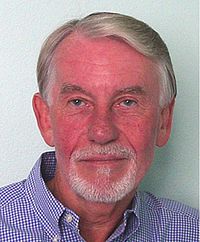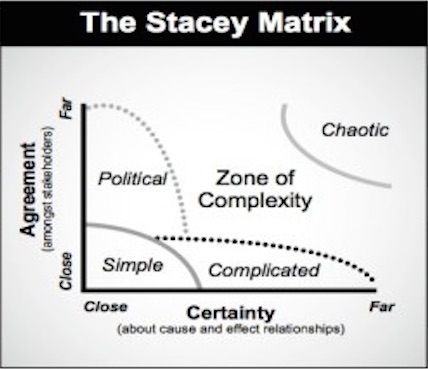Changing conversations based on the Stacey matrix
Developed by Bianka Zsuzsanna Juhász

This report is devised in the course 42433 Advanced Engineering Project, Program and Portfolio Management at the Technical University of Denmark in Autumn 2015.
The Stacey matrix model was proposed by Ralph Douglas Stacey. It gives the possibility to distinguish management decisions and deal with Complexity and Uncertainty in organization platform. The result is brought out by usage of the two dimensions Stacey matrix. It allows us to compare the level of agreement amongst stakeholders with the degree of certainty about the relationships between cause and effect. Thus, the decision can fall into the following areas of the matrix for further analysis: Simple, Complicated, Political and Chaotic. [2]
Contents |
The idea of the strategic choice theory
Ralph D. Stacey defined management and organization dynamics in frame of the strategic choice theory. In this view the organization changes over time in a direction chosen by the most powerful individual or small group of managers. The theory of strategic choice displays its theoretical origin in two main pillars; cybernetic system theory and cognitivist psychology. Cybernetic theory is highly focused on control and regulation of a system, which helps to guide and return into the state of stabile equilibrium in order to reach the desired destination. The cognitivist psychology describes the nature of Human Behaviour in this context.
In the aspect and understanding of strategic choice, important parameters are to consider cause and effect uncertainty and conflict. These are main properties of decision-making, which appears in the management of an organization including project, program and portfolio management.
The Stacey matrix model introduces the phenomenon of strategic choice in the organization management by taking uncertainty and management agreement into consideration.
Application of the Stacey matrix

Background
As antecedent representatives, Thompson and Tuden (1959) have already related to the effect of uncertainty on decision-making mode in a similar manner. [4] They defined that uncertainty originates in the lack of clarity and the lack of agreement over objectives. Managers are mentioned as objectives. This aligns with the theory of Ralph D. Stacey (2000). [2]
The Stacey matrix
The Stacey matrix places a decision by identifying the level of agreement amongst stakeholders and the level of certainty about the cause and effect relationships. There are the parameters appearing on the axes of the matrix as can be seen in Figure 2. The scale is defined between close and far. The closest the parameter is marked, the highest the level is.
If the relationships between cause and effect are highly certain, as well as having agreement amongst the different stakeholders, the conditions for a simple decision-making case are present. In Figure 2, the area called Simple shows this situation. In this situation, the management makes the decisions in a rational, logical way. [5] When the aimed direction, destination and circumstances are clear at a company, this can be the case of certain decisions. The right answer exists and a simple fact-based, traditional management situation arises. Although, as moving away from the so-called “Simple” field, the application of rational logic will be critical and different approaches are getting necessary to use.
When there is a high certainty and the causal connections are still clear, but managers conflict then the decision has to be made on Political manner. This proposes that the one with the biggest power will dominate and the strongest individual who builds coalitions will control the decision-making. [6] [7] Here it is an important aspect to build relationships, negotiate and compromise in order to gain further steps.
When the managers agree on the desires aimed to achieve but the causal connections are uncertain and make the situation unclear how to deal with, then it falls into the zone of so-called Complicated. The usage of judgmental or intuitive modes of decision-making is necessary to execute. In this case, more than one right answer is possible, therefore, the feasibility is judged with the interaction and coordination of expertise. The reasoning is mostly analog. They need think in a literal way, taking trial-and-error cases into account to progress into decision.
The most problematic situation is when there is not agreement nor certainty, all is unclear and the objectives conflict. This level of complexity is referred to as Chaotic. The atmosphere can be decried with the main factors of tension, turbulence and lack of any patterns. In an organization this is a situation, which really needs to be avoid. Here the manager has to decide based on intuitive individual judgment combined with the political interactions of the group. [2]
Models of decision making in conditions of certainty
This section introduces three well-known models of decision-making in the conditions of certainty.
Technical rationality
Technical rationality is an effective mode of decision-making in the situation when stakeholders are aware of their objectives and they are in agreement. Frederick Taylor (1911) established the theory of a scientific management where pure rationality prevails. [8]
Scientific managers are continuously scanning and researching the facts changing with the environment. Thus, they discover the way, how the capability of the organization is changing, too. By analyzing these facts, they apply step-by-step rules of logical consequences to bring out the possible options or routes. Considering their organization objectives, they calculate the effect of each option and choose the one, which maximizes the objectives. Afterwards, they also act on behalf to implement this option.
This method has two limitations. It only works if the stabile dynamics exists by being close both to agreement and to cause and effect certainty. On the other hand, another limitation originates from the human cognition. Pure rationality requires direct perception without any distortion. The person would have to memorize and store all facts in an exact way they have been observed. This way, the choice should be predetermined purely and directly by the facts. However, human manner is recognized not to be able to perceive facts and environment directly and purely on rational basis. [2]
Bounded rationality, bureaucracy and dominant coalitions
Recognizing the limitations of the pure technical rationality model, ‘’’bounded rationality’’’ model was developed by Herbert Simon (1960). [9] Bounded rationality is a weak form of technical rationality. It admits the limitation in economic resources such as in experience and knowledge. The nature of human brain provides only limited intellectual abilities, which also restrict the flow of communication in an organization. In these circumstances, instead of screening all the options, the managers only identify the most important information and options. It follows that they cannot maximize their objectives. Rather they satisfice them. They achieve the first action in the range of satisfactory in the given circumstances and limitations.
Managers also aimed to reduce the number of the decision-makings in order to compensate the limited resources and brain processing capacities. Thus, precedents were established based on previous cases and experience. This procedure is the so-called ‘’’bureaucracy’’’. This way, managers seek to avoid having to repeat the processes over and over again. Decisions happen to be outputs of same patterns. For instance, the budget of an organization for the coming year is often determined by the rate of expenses and spends of this year. Thus, by applying the bureaucratic roles, the goal is not to optimize the outcomes but rather to reduce the level of uncertainty faced during decision-making procedures. [9] [10]
In numerous cases, although the objectives are clear and indicating a high certainty, the interests conflict. There is no agreement between different stakeholders. In this situation, the most powerful coalition formed from managers will be the one bringing the outcome and taking action. This is the model of the ‘’’dominant coalition’’’. [10]
Trial and error or logical incrementalism
This is a research-based model, which was discovered and developed by Quinn’s investigation (1980). [11]
It is seen from Quinn’s research that large number of companies and effective managers are making strategic decisions not based on formal planning models such as the ones described in the paragraphs above. Rather they interfuse behavioural, political and formal analytical processes. This is a planned strategy. There effective managers accept the fact of high rate of uncertainty and do not plan everything. They only have the goal defined, therefore, the destination is strongly intended. However, they leave a certain amount of flexibility for the company to deal with. There is no prior central intension how the goal should be reached, but goal is a motivation force showing the direction. The route is discovered by ‘one step at a time’ logical process. Through the whole way, there is possibility to learn and adjust the overall strategy by taking small steps as well as trial-and-error actions. The managers oversee the process and sustain some logic. On the other hand, they leave the organization to handle unforeseen happenings. Urgent and piecemeal decisions shape the future approach of the company towards its goal. It follows an orderly logical way by these minor decisions. They are always prepared to move opportunistically.
To conclude, the Quinn’s research showed a lifelike adjusted way of management of processing decisions. Only the start and end point is defined. The route to achieve the goal on is flexible and formed by small step decisions and trial-error processes.
Limitations of the Stacey matrix model
The Stacey matrix is good to apply for the initial phase of decision-making. Its purpose is to examine the connection between cause and effect certainty and stakeholder agreement. In this regard, it gives guideline which model is worth to use for further analysis and steps in decision-making.
Thus, the Stacey matrix can only inform about the state of decision-making and navigate in the initial phase.
The other limitation is drawn by the fact of human behaviour. As its consequence, there are no sharp borderlines indicated between certain areas of the matrix. Each situation vary, this is what gives the challenge of handling complexity in management.
Related articles
Annotated bibliography
- ↑ http://www.canterbury.ac.uk/news/newsRelease.asp?newsPk=881
- ↑ 2.0 2.1 2.2 2.3 Ralph D Stacey (2000); Strategic Management and Organization Dynamics, The challenge of Complexity, Pearson Education, England
- ↑ http://be-in-unison.com/wp-content/uploads/2014/02/staceymatrix1.jpg
- ↑ J. D. Thompson, A. Tuden (1959); Strategies, structures and processes of organizational decision, University of Pittsburgh Press., Pittsburgh.
- ↑ R. Turton (1991); Behaviour in a Business Context, London: Chapman and Hall.
- ↑ J. Child (1972); Organizational structure, environment and performance: the role of strategic choice, Sociology, vol. 6, no. 1, pp. 1-21.
- ↑ J. Pfeffer (1981); Power in Organizations, Cambridge, MA: Ballinger.
- ↑ F. Taylor (1911); Scientific Management, New York: Harper Brothers.
- ↑ 9.0 9.1 H. A. Simon (1960); The New Science of Management Decisions, New York: Harper Brothers.
- ↑ 10.0 10.1 R. M. Cyert, J. G. March (1963); A Behavioural Theory of the Firm, Englewood Cliffs, NJ: Prentice Hall.
- ↑ J. B. Quinn (1980); Strategic Change: Logical Incrementalism, Homewood, IL: Richard D. Irwin.